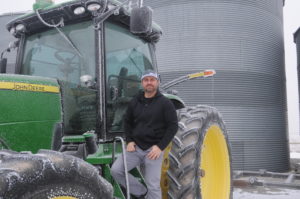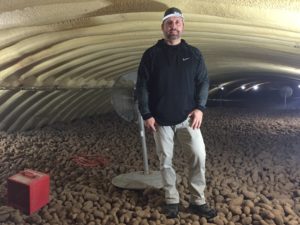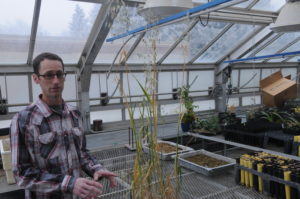
Protecting the Soil: Cover crops key to keeping one small farm alive
Rob Giesbrecht believes a key to keeping his small potato farm in business has been his willingness to try new management practices for the sake of replenishing his soil.
For the past two decades, the Eastern Idaho farmer has touted one tool in particular for improving soil health – cover crops. Giesbrecht said cover crops – which are planted primarily for soil health benefits rather than commercial sale – have helped him reduce tillage, build soil organic matter, control weeds and pests, better capture natural moisture and reduce inputs.
“I don’t care how good of a farmer you are,” Giesbrecht said. “If your soil is severely lacking, you are at a disadvantage before you even put the seed in the ground.” Giesbrecht, 43, has been driving tractors and moving irrigation pipe since he was 13 and has deep agricultural roots in the Aberdeen area. His grandfather, Henry, who was the son of German immigrants, had a small local animal farm. Giesbrecht’s father, Richard, bought 320 acres of cropland in the community in the late 1960s. Giesbrecht earned a bachelor’s degree in accounting from Idaho State University but returned to the farm, where he and his father farmed together until Richard was killed in a 2010 car accident.
Farming is Giesbrecht’s greatest passion, and he said he’s had to continue learning and evolving his practices to remain solvent in a business climate that’s growing increasingly challenging for small producers.

“My interests really are all about farming,” Giesbrecht said. “A great trip to me is going to another part of the U.S. and understanding the things they do in farming, and understanding how I can incorporate some of their things into my farm.” Giesbrecht now farms about 1,400 acres, including some leased ground, and has a four-year rotation comprising potatoes, two seasons of wheat for seed and sugar beets. He typically plants about 400 acres of spuds, including chipping potatoes and Russet Burbanks for processing.
“It’s an extreme challenge (for small farmers) right now, especially with (low) commodity prices,” Giesbrecht said. “The key is you have to make every acre as profitable as possible.” He and his wife, Hailey, who is a cheerleading coach at American Falls High School, hope to one day pass the farm on to one of their four children: Madison, 20; Connor, 19; Italie, 9; and Prescott, 3.
Giesbrecht also supplements his farm income by selling cover crop seed. He conducts informal trials, both to guide his own cover crop management decisions and help him advise customers. Soon, he plans to start raising cover crop seeds for commercial sale, which will further diversify his crop rotation. At least with using cover crops, Giesbrecht believes small farms have an advantage. He explained cover crops require a lot of work, and small farms tend to have greater flexibility to handle the extra planning and adjust the timing of certain farm activities.

bottom line and soil are both healthy.
“The best way to make cover crops work is to have a management plan months in advance of planting and be willing to adjust on the fly,” Giesbrecht said. “You’ve got to let cover crops grow as long as possible.”
Cover crops compete against weeds, thereby reducing his reliance on herbicides. Some species fix nitrogen, saving on his fertilizer costs. He warns farmers who may be interested in trying cover crops that they’re not a “one-year cure-all.” But even in the initial years, they can help a farmer reduce tillage. Following wheat harvest, Giesbrecht explained cover crops create a microclimate that expedites the decomposition of stubble, making it easier to plant a subsequent potato crop without heavy tillage. Cover crop roots reduce erosion, provide a conduit for natural moisture to enter the soil and prevent soil compaction, further reducing the need for tillage. Furthermore, Giesbrecht avoids tillage by necessity because cover crops need time to grow to fully convey their benefits.
When cover crops decompose, they build up soil organic matter, which supports beneficial soil organisms, holds moisture, improves soil structure, aids in making micronutrients available to plants and holds key nutrients until they’re needed to support plant growth. Giesbrecht explained tilling soil can reduce its organic matter by half.
Potato farmers can’t avoid disturbing their soils at harvest, so Giesbrecht argues it’s especially important for them to cut back on tillage elsewhere in their rotations. Giesbrecht explained most U.S. soils are depleted, and farmers notice the importance of organic matter when they enjoy a yield boost after breaking out new ground. “Organic matter as far as I’m concerned is the missing ingredient to taking our soils to the next level of production,” Giesbrecht said. One of Giesbrecht’s most recent cover crop experiments has been with red clover – a nitrogen-fixing plant that can lend more than 100 units of nitrogen per acre to a field when allowed at least nine months to grow.
To give red clover sufficient time to do its job, Giesbrecht has been using it as a “companion” crop, which is seeded in the same field as a cash crop. When interspersed with wheat, Giesbrecht said red clover provides a small nitrogen boost to help his grain crop, and he allows the clover to continue growing after his wheat is harvested. Often, he uses multi-species cover crop seed blends to mimic the diversity in nature and deliver a broader range of soil benefits. But if he were forced to choose a single cover crop species for use in a potato rotation, Giesbrecht would turn to oilseed radish. The plant’s deep taproot aids in water infiltration and recovers nutrients missed by previous crops. Oilseed radish also helps control nematodes that can reduce potato yields. It’s a “trap crop,” which stimulates nematodes to lay their eggs but doesn’t provide a viable food source, leaving the newly hatched microscopic worms to die. It also leaches a natural fumigant, called glucosinolate, into the soil.
Giesbrecht explained an exceptional oilseed radish crop provides nematode control roughly equivalent to 15 gallons per acre of metam sodium fumigant.
“If a field truly needs an intense fumigation, you can’t replace it with a cover crop,” Giesbrecht added. Giesbrecht plants his oilseed radishes after his summer wheat harvest. His radish variety, called Defender, can survive until winter temperatures drop below 15 degrees. He usually chops the vegetation off of oilseed radish cover crops so they’ll decompose, eliminating the need for intensive bed preparation when he plants potatoes the next spring.
For comparison, however, he’s left radish vines and other crop vegetation intact this fall within a few small plots, at the request of Terron Pickett, an agronomist with the Aberdeen Plant Materials Center, operated by USDA’s Natural Resources Conservation Service (NRCS). Giesbrecht and Pickett have been sharing findings with one another from their separate cover crop trials. “Any time when the ground is bare, there’s an opportunity for cover crops,” Pickett said, explaining cover crops provide soil “armor,” protecting it from erosion. Pickett said research has been ongoing since 2015 at the 25 NRCS Plant Materials Centers to evaluate which cover crops are best suited for the conditions in each region.
He’s been working with subspecies of hairy vetch, winter pea, red clover, crimson clover, balansa clover, black oat, cereal rye and radish at the Aberdeen facility. Pickett emphasized that growers derive a more direct financial benefit from their cover crops by grazing them with livestock, which re-circulate the plant nutrients through their excrement.
In Eastern Idaho, he believes cover crops will also prove to be a popular tool in helping growers retain soil moisture. The terms of a 2015 water call settlement mandate that junior groundwater irrigators who draw from the region’s aquifer must reduce their annual irrigation by roughly 12 percent on average. NRCS estimates a single percentage increase in soil organic matter boosts the moisture-holding capacity of soil by 25,000 gallons per acre.
“In the long run, soils can be more drought tolerant using cover crops,” Pickett said. Aside from his focus on soil, Giesbrecht has creative ideas for using his farm to better his community. He plans to plant several food crops within a 7-acre field and invite local residents experiencing hard times to harvest as much food as they need, free of charge. Giesbrecht said he’s still working on the details and the legalities of his community garden.














